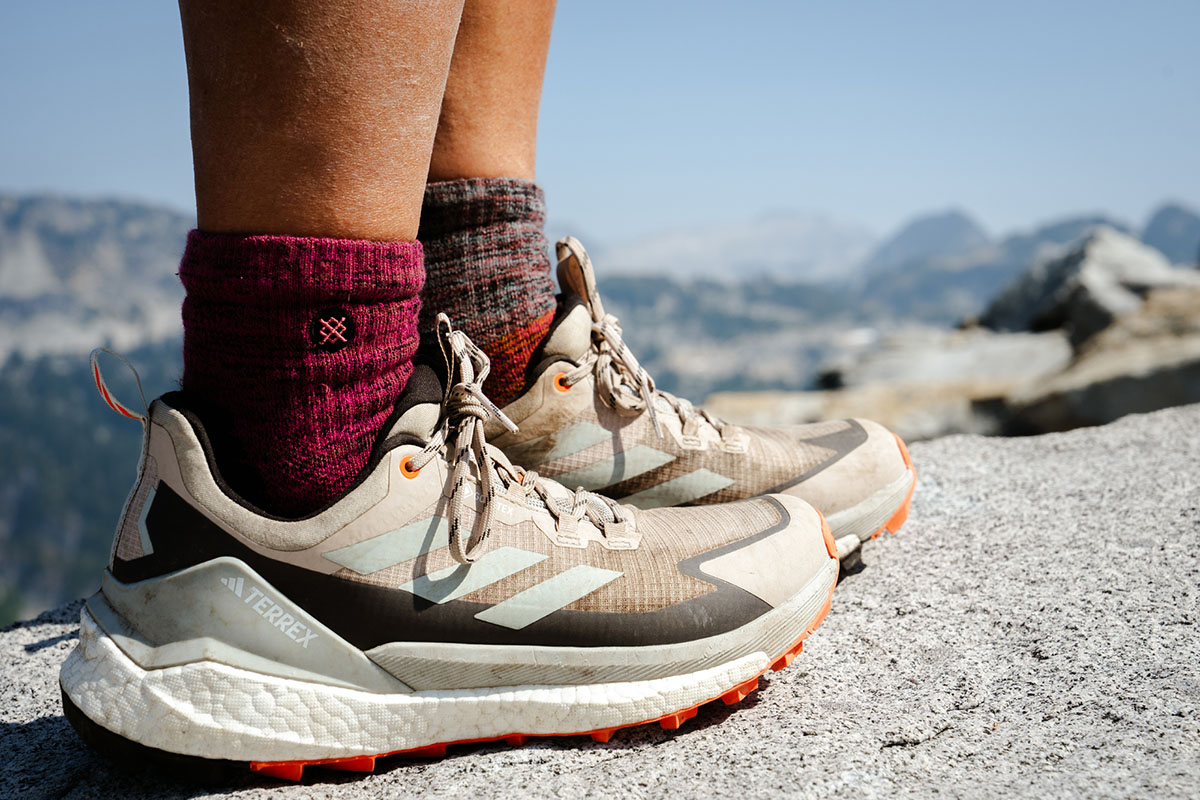
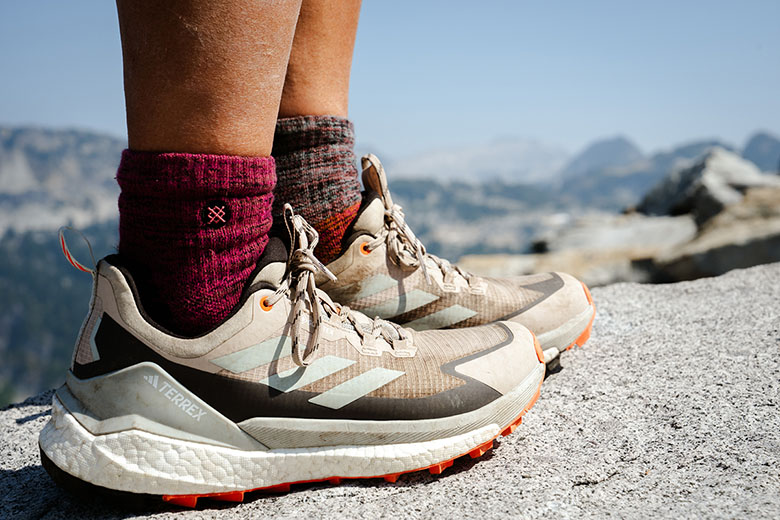
Price: $180
Weight: 1 lb. 15.1 oz. (women’s 9)
Waterproof: Yes (Gore-Tex)
What we like: Noticeably more protective and stable than most lightweight hiking shoes; impressive traction.
What we don’t: Heavy, stiff components, and not as plush or comfortable as other designs.
See the Women's Free Hiker 2 Low GTX See the Men's Free Hiker Low 2 GTX
Adidas isn’t the first brand you might associate with high-performance hiking footwear, but their Terrex collection has come on strong in recent years. We took the Terrex Free Hiker 2 Low GTX hiking in Washington’s Alpine Lakes Wilderness and were impressed with the shoe’s confidence-inspiring grip, stability on off-camber terrain, and great build quality. It’s not the lightest or most aesthetically pleasing hiking shoe (at least in our opinion), but it checks all the boxes for heavy-duty use. Below we break down the Terrex Free Hiker 2 Low GTX’s overall performance. To see how it stacks up against the competition, see our articles on the best hiking shoes and best women’s hiking shoes.
The design of the Adidas Terrex Free Hiker 2 Low GTX is fairly rigid overall, including a burly sole, tough ripstop mesh upper, and noticeably stiff and tall heel counter, which extends well past the crook of my ankle at the back. It’s also pretty heavy for a hiking shoe. I was initially concerned with how this design would play out during long stints on the trail (especially straight out of the box), but I came away from the trip with few comfort complaints. My only gripes were with the shoe’s clunky feel and its unnecessarily high heel counter, which could cause pressure points or rubbing. 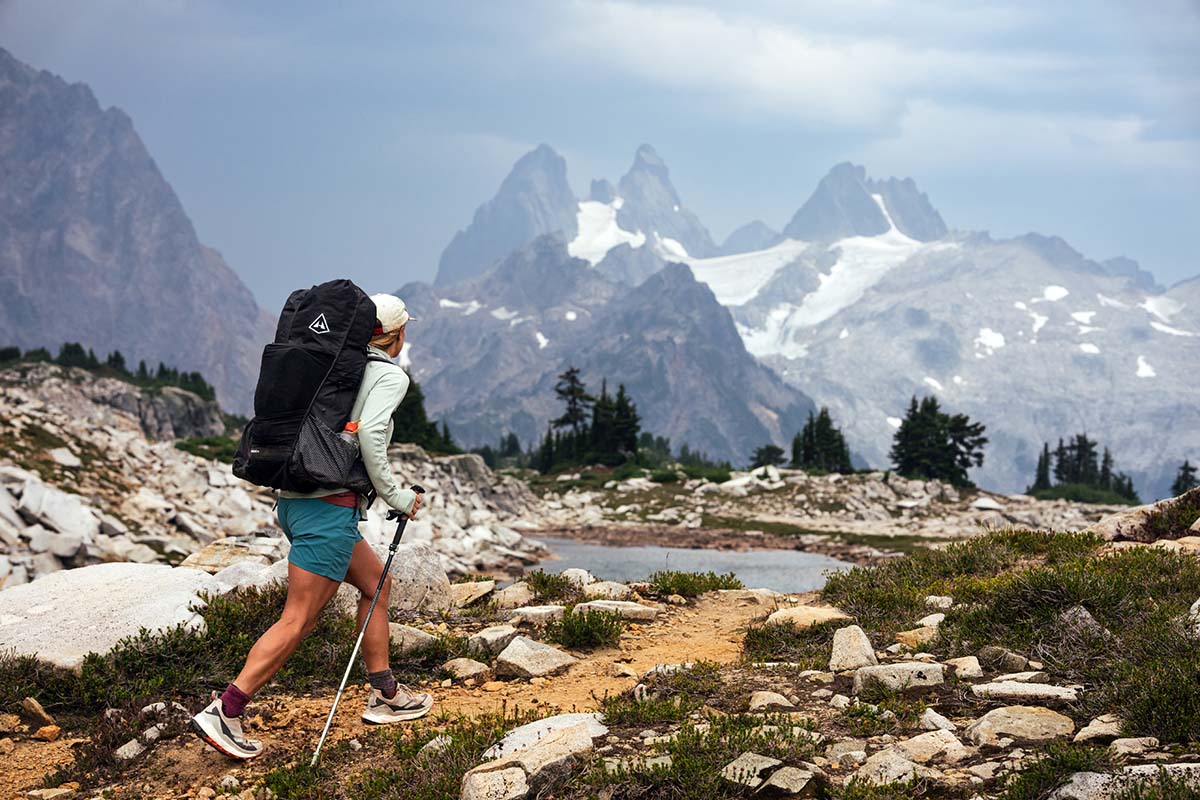
On the bright side, I found the Free Hiker’s Boost midsole cushioning to be nicely balanced and neither too plush nor too stiff. It threads the needle between a bouncy trail runner and a firmer feeling approach shoe and is a great match for routes that include both easy trail and technical terrain. The shoe also has a relatively pliable forefoot (when we take it in our hands and bend the sole, it’s stiff past the arch and then flexible to the toe), which lends itself to excellent walkability. All told, if you’re expecting the feel of a trail runner or lightweight hiking shoe—including a flexible and airy upper and soft cushioning throughout—the Free Hiker 2 Low is overkill; but for a supportive, protective, and durable hiking shoe, it's surprisingly comfortable despite its rigid components.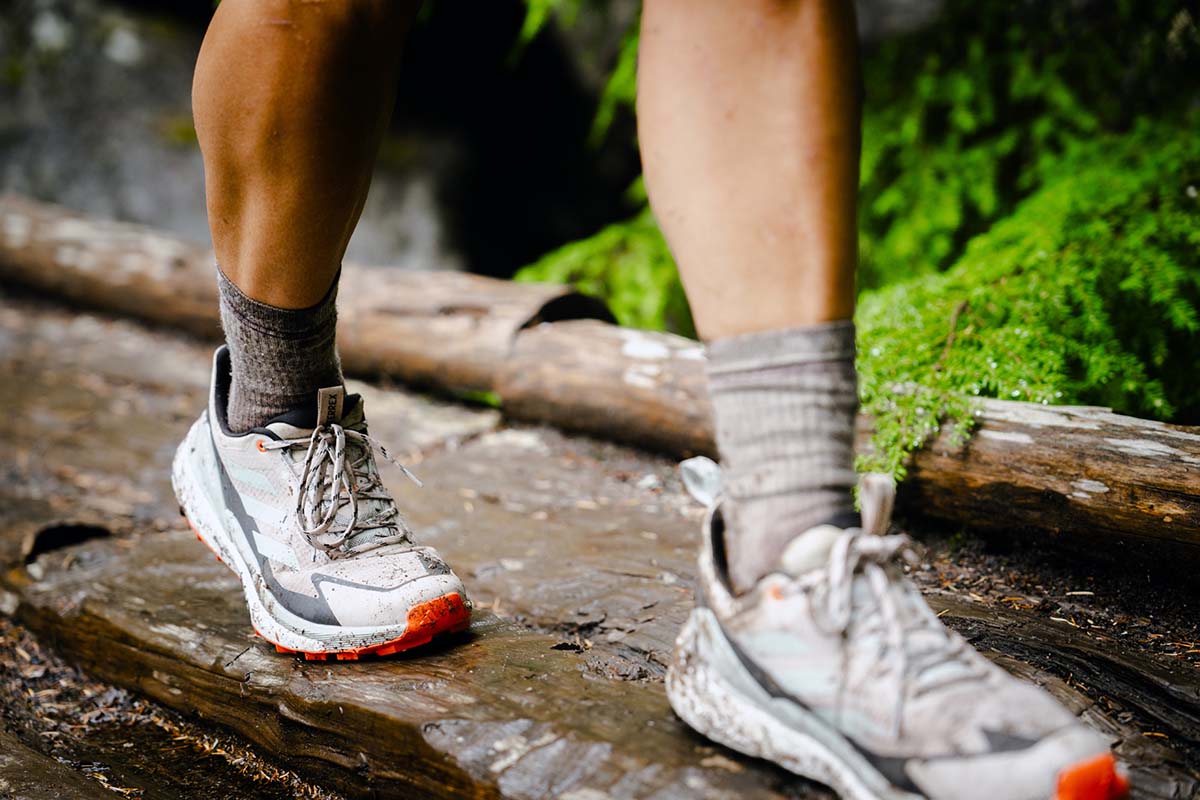
The Free Hiker 2 Low checks in at 1 pound 15.1 ounces for a women's size 9 (the women’s 7.5 is listed at 1 lb. 9.8 oz.), which is on the heavy side for a hiking shoe. For comparison, our top-ranked Merrell Moab Speed weighs only 1 pound 5 ounces for the pair, and even the burly La Sportiva Spire GTX (our pick for the best supportive shoe for backpacking) comes in 5 ounces less at 1 pound 10.2 ounces. In fact, we’ve worn a lot of hiking boots that weigh less than the Free Hiker 2 Low despite their boost in ankle support.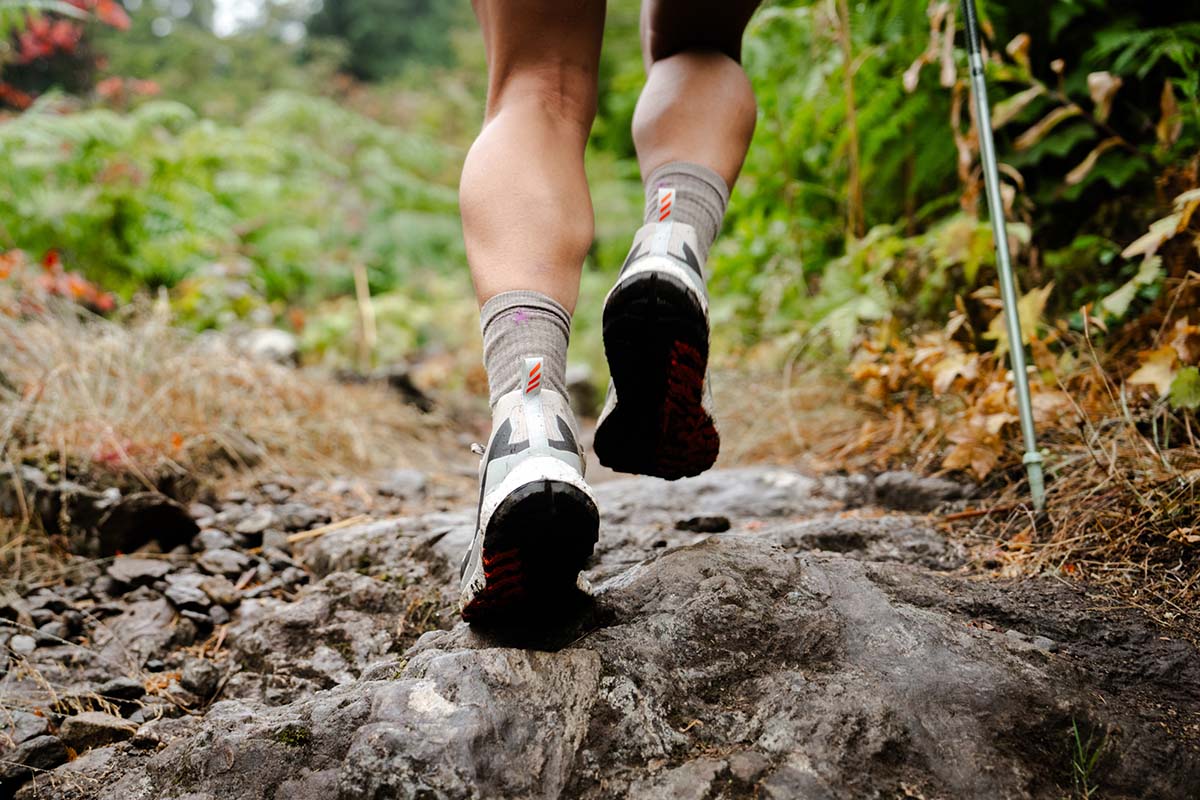
What does this mean in practice? I wore the Free Hiker 2 Low during long days of hiking in the Alpine Lakes backcountry and have mixed feelings on its heft. The shoe didn’t necessarily slow me down with its weight, but every step did feel heavy and clunky, far from the nimble experience I expect from a hiking shoe that looks like a trail runner. It doesn’t help that the bulk of the ounces are concentrated at the heel. On the other hand, I did have the sensation that I could step anywhere with confidence—especially loose terrain like scree and snow. All told, if you plan to carry a decent load or put a premium on support and protection, the Free Hiker 2 Low’s weight might be worth it. But for everyday hikers and backpackers who frequent easy trails with light packs, it’s overkill.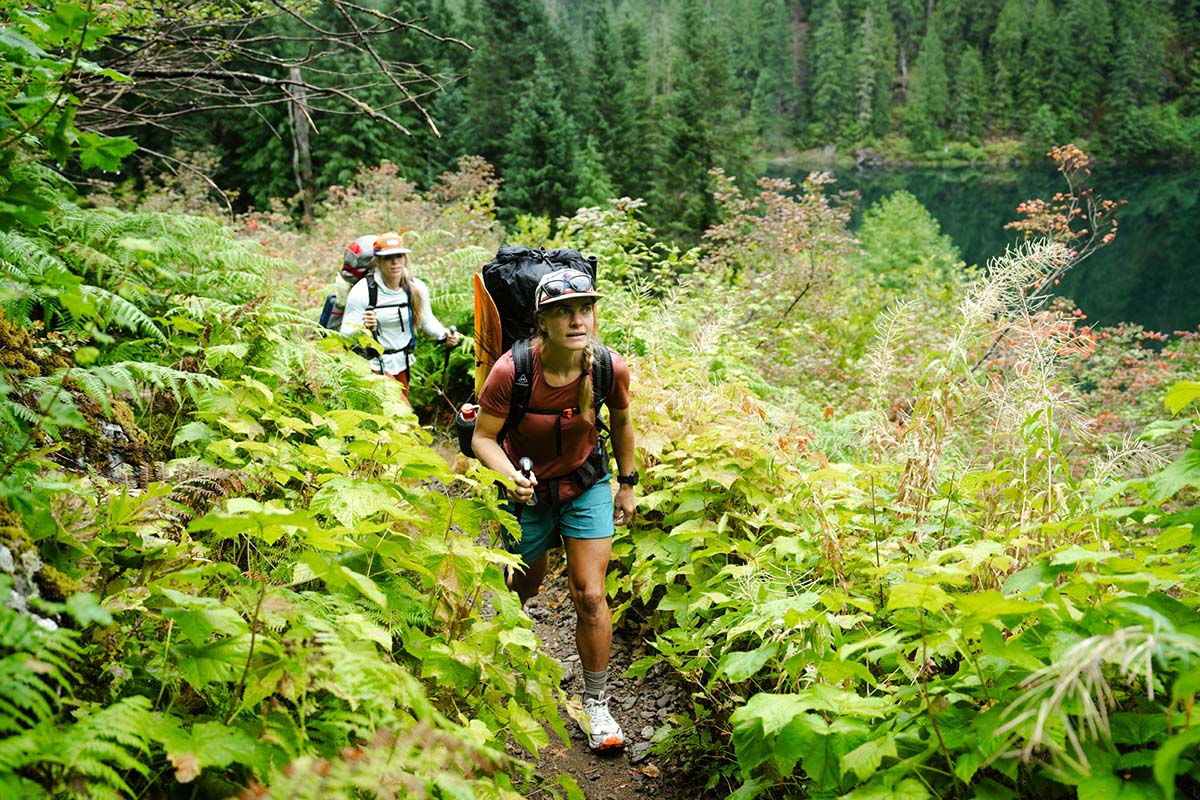
Hiking cross-country through the Alpine Lakes Wilderness was a great testing ground for traction, and the Free Hiker 2 Low passed with flying colors. The shoe offered confidence-inspiring grip on everything from slick singletrack to lichen-covered rock and loose scree, even in soaking wet conditions. This impressive traction (some of the best I’ve experienced from a hiking shoe) is thanks to a Continental rubber sole with a distinctive chevroned tread pattern. The well-spaced lugs help prevent mud from caking, and the rubber is noticeably hard, which should help with longevity. After putting some pretty demanding miles, there aren’t many signs of wear underfoot, which is promising for long-term durability.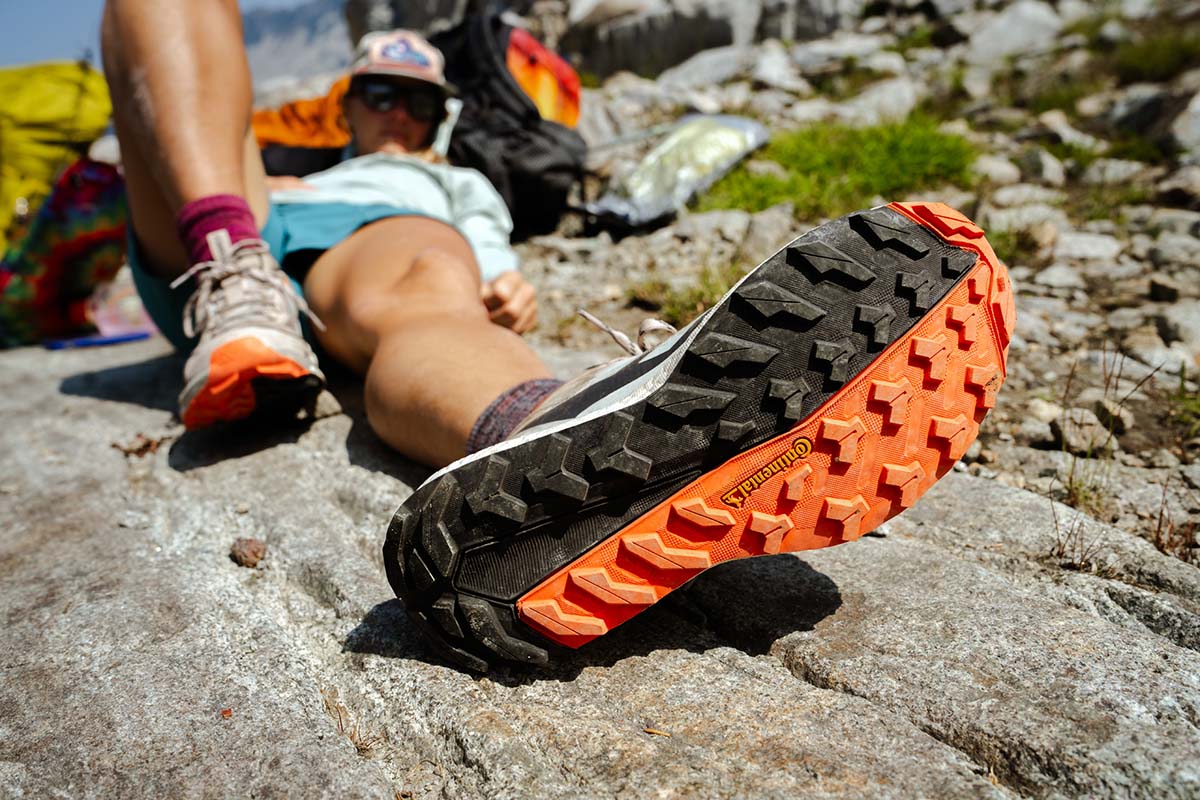
Protection is one of the Free Hiker 2 Low’s clearest strengths. Underfoot, the rigid heel cup and stiff sole provide considerably more separation from the trail than most lightweight designs (like my hiking partners' Topo Athletic Ultraventure 3 and Brooks Cascadia 17). The protection also extends around the toes and sides of the feet via a burly, reinforced upper. For mountainous terrain like we experienced in the Alpine Lakes Wilderness, this feeling of being isolated from the elements is a huge boon: I moved across boulder fields and down scree slopes confidently, without having to consider the terrain’s impact on my feet. I certainly don’t feel the need for this level of protection on easy trails, but it’s a welcome trait for technical, above-treeline routes.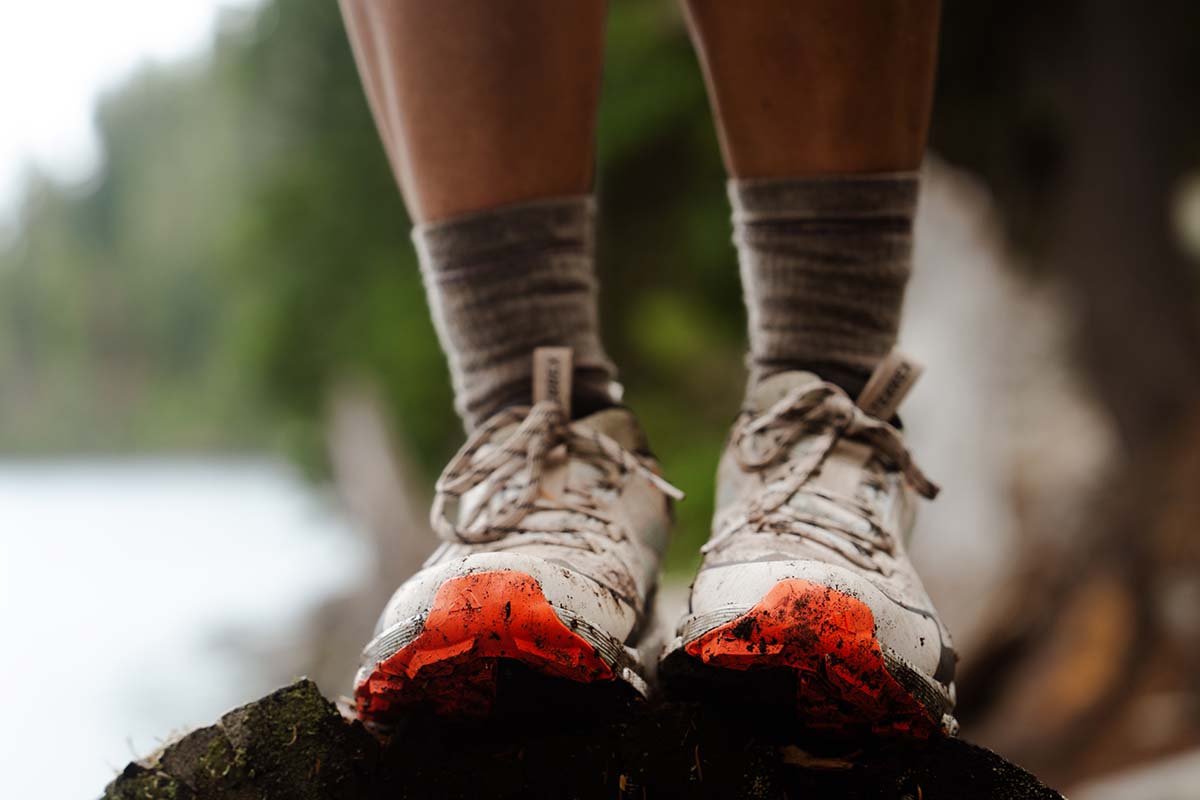
As with protection, the Free Hiker 2 Low is very impressive in terms of stability. The rigid structure isn’t at the whim of the terrain like most lightweight designs, and provides a very stable platform from which to move. And while you do get some added bounce and comfort from the Boost midsole, it’s still on the firm side and is a wonderful foundation on off-camber terrain. I was also pleased with the lacing system, which securely locked my foot into place and was not prone to loosening throughout the day. Our journey through the Alpine Lakes included a lot of boulder hopping and steep, loose terrain, and the Free Hiker 2 was a formidable companion through it all. 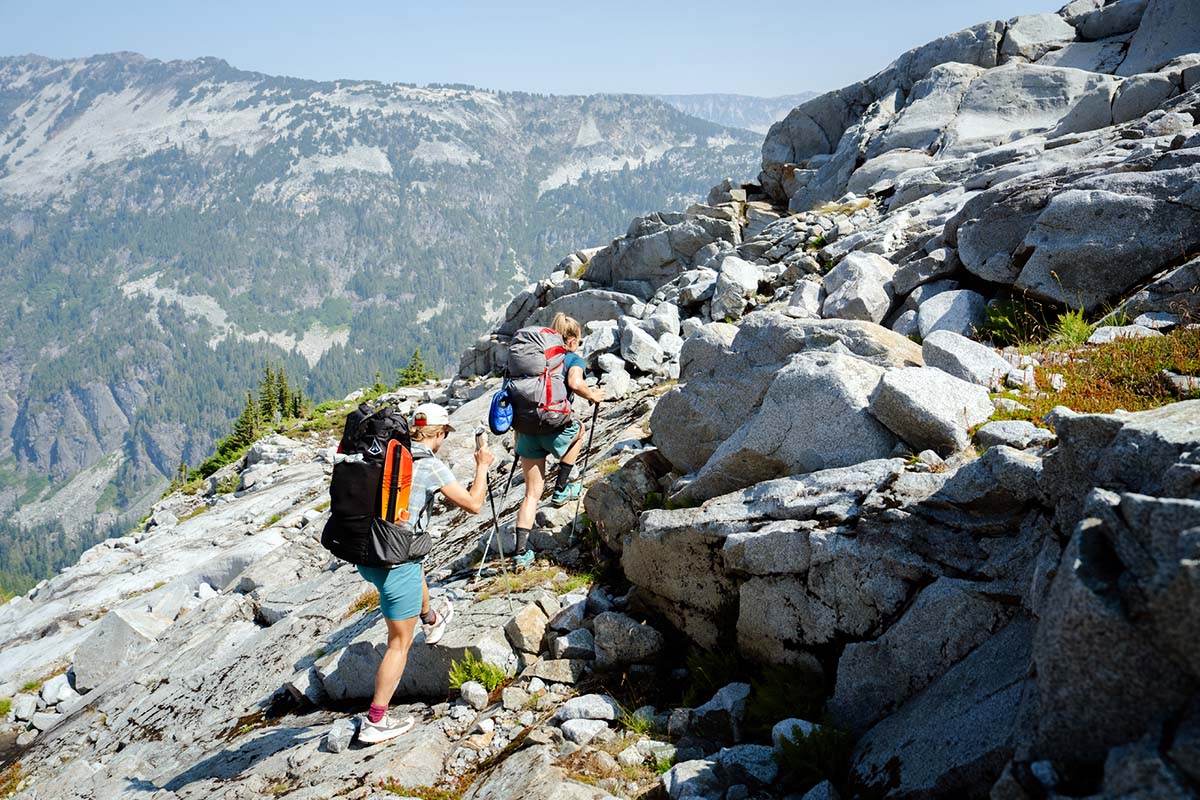
As I mentioned in the comfort section above, the Free Hiker 2 Low is noticeably stiff underfoot through the arch, but the toe remains pliable to encourage walkability. This does have its shortcomings on truly technical terrain, where we might prefer the stiffness of an approach shoe (like the La Sportiva TX4) or burlier mountain boot instead. But for routes that include both easy hiking and cross-country travel, it’s a fantastic compromise. All told, Free Hiker 2 Low is a great middle ground between a lightweight hiking shoe and a full-on boot and an ideal choice for moving quickly in varied terrain. 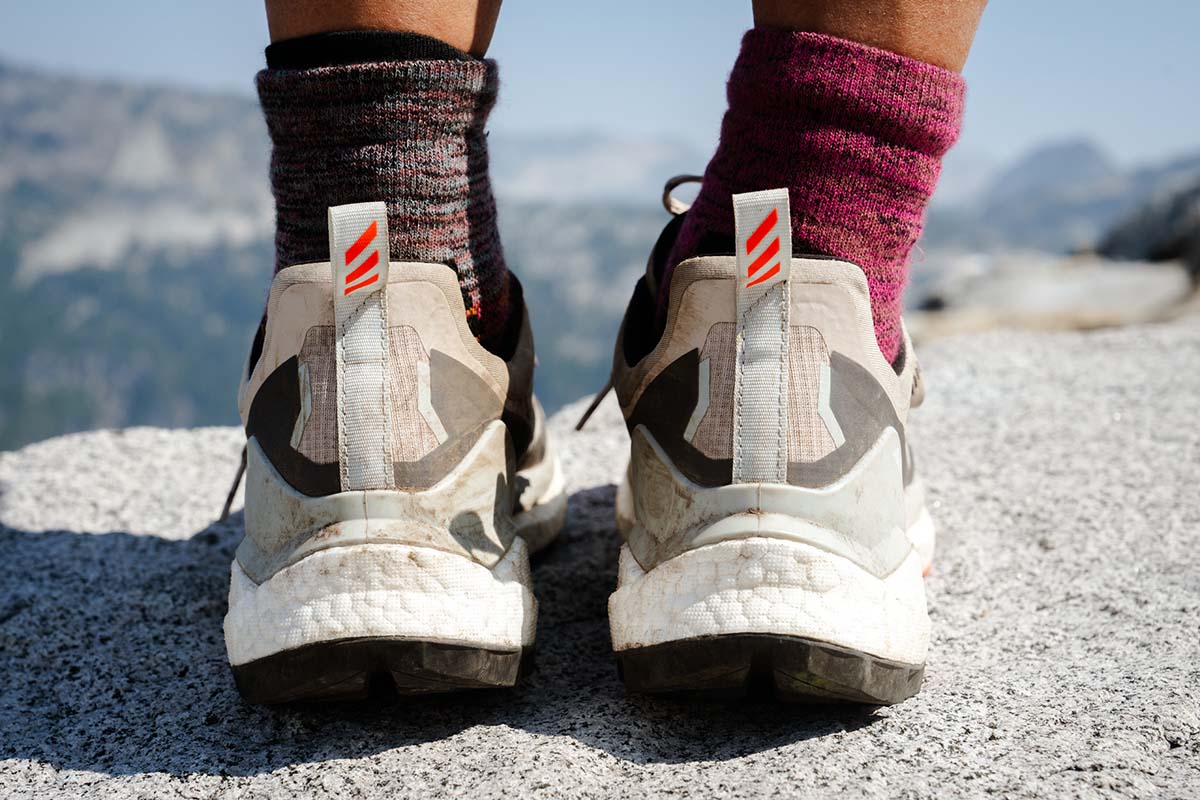
The Free Hiker 2 Low comes with a Gore-Tex liner, making it fully waterproof below the ankle. Wet weather and no shortage of creek crossings allowed me to give the waterproofing a run for its money, and it proved to be very capable. Keep in mind that you don’t get as much water protection with the low-top design, but the Free Hiker 2 Low nevertheless gets the job done for shallow streams and small puddles. And although breathability is a common shortcoming with GTX shoes, my feet didn’t overheat despite warm and sunny conditions during the middle of our trip. But despite the Terrex’s great performance, I recommend thinking twice before opting for a waterproof hiking shoe. If you’re hiking in hot, dry places and can easily let your shoes dry when wet, a non-waterproof model is likely a better bet (for more, see our article Do You Need Waterproof Hiking Shoes?).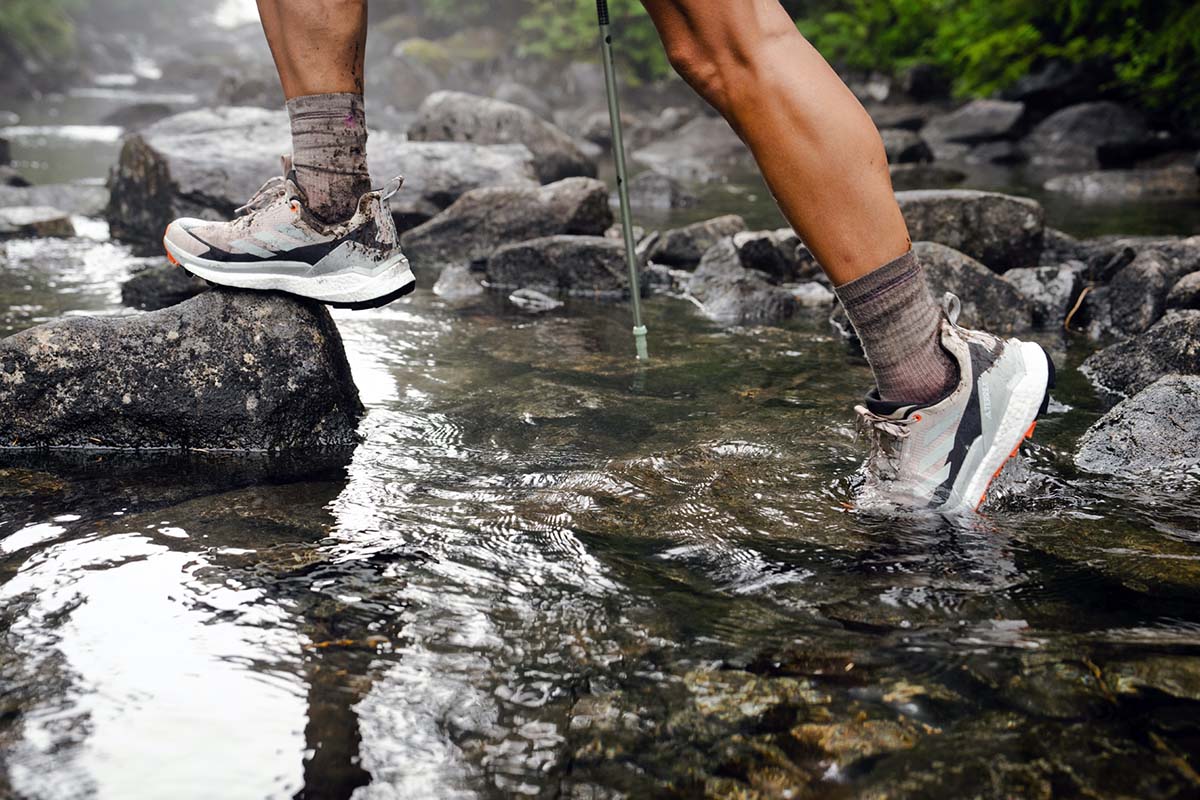
As expected given the levels of protection and stability, the Adidas Terrex Free Hiker 2 Low GTX is a very hardwearing and well-built design. The Continental rubber outsole is decidedly substantial and hard, which will likely fare well over the long term (there are no significant signs of wear thus far), and the synthetic upper is tightly woven with armor-like reinforcements in key places like the sides and back of the shoe. I’ve taken a lot of shoes on 3- to 4-day test drives in mountainous terrain, and the Free Hiker 2 fared considerably better than most, even compared to some leather designs. Thus far, everything looks close to new, and I expect the shoe to have a very long lifespan.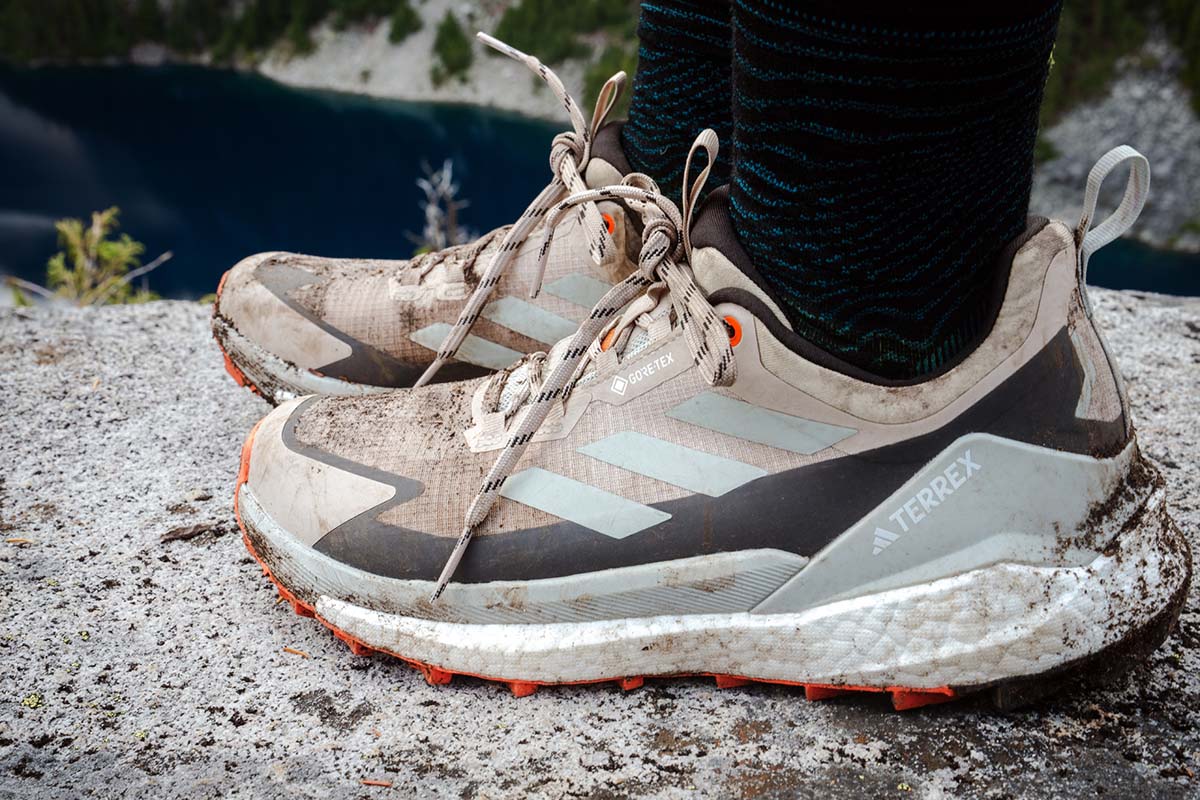
The Adidas Terrex Free Hiker 2 Low runs large, and I strongly recommend sizing down if you’re between sizes. I’m generally between a women’s size 8.5 and 9 and opted for the larger size; when the shoes came in the mail, I couldn’t believe how long they were. I doubled up my hiking socks and was able to complete our hike in the Free Hiker thanks to a pretty solid ankle lock, but felt like I was wearing clown shoes the entire time. It's also worth noting that the shoes are not particularly wide in the toe box but have a noticeably roomy heel. All told, my experience is that Terrex's sizing is off enough that your best bet is to try on the Free Hiker 2 Low before buying (or purchase multiple sizes from a reputable online retailer).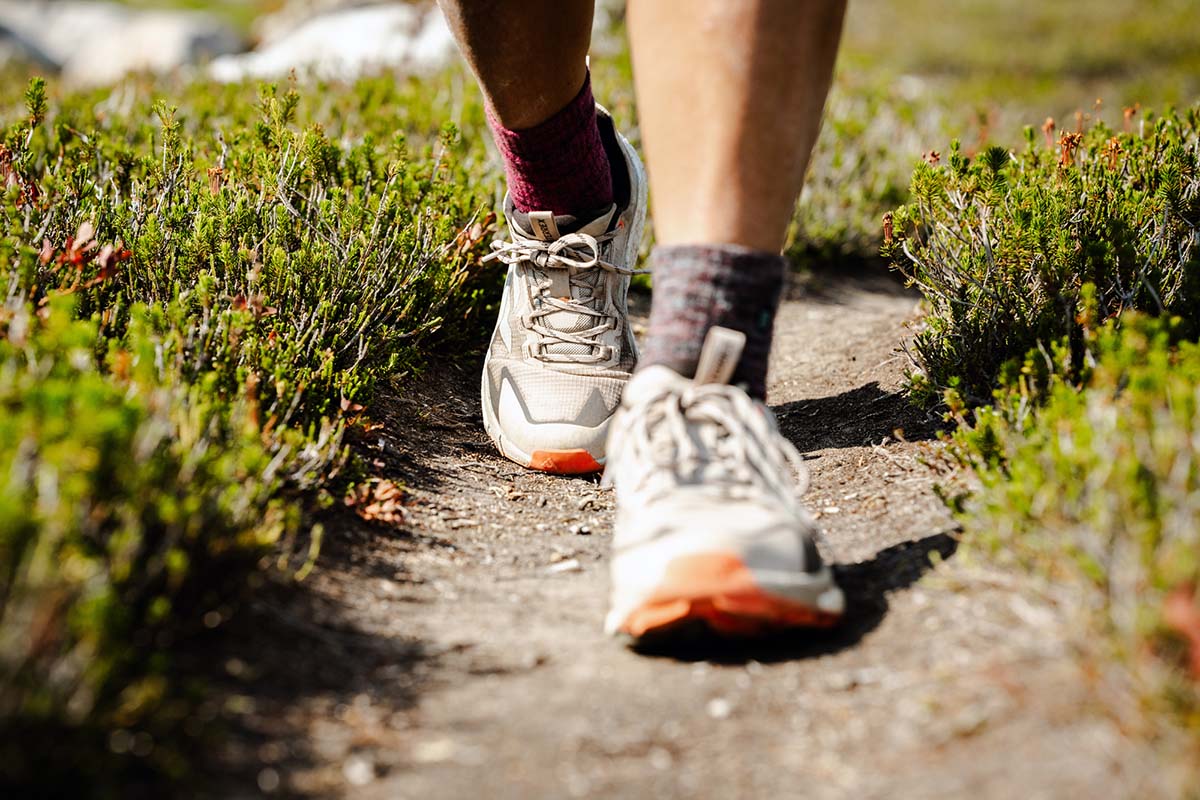
We tested the women’s version of the Terrex Free Hiker 2 GTX, but Adidas also makes a men’s-specific model with a nearly identical design, varying colorways, and the same price ($180). For those who prefer over-the-ankle coverage, Adidas offers the Free Hiker 2 in mid-height boots for men and women, which are available in both waterproof ($230) and non-waterproof ($200) varieties (the non-waterproof model has a unique, raised knit collar). Interestingly, Adidas does not make a non-waterproof variation of the low-top hiker.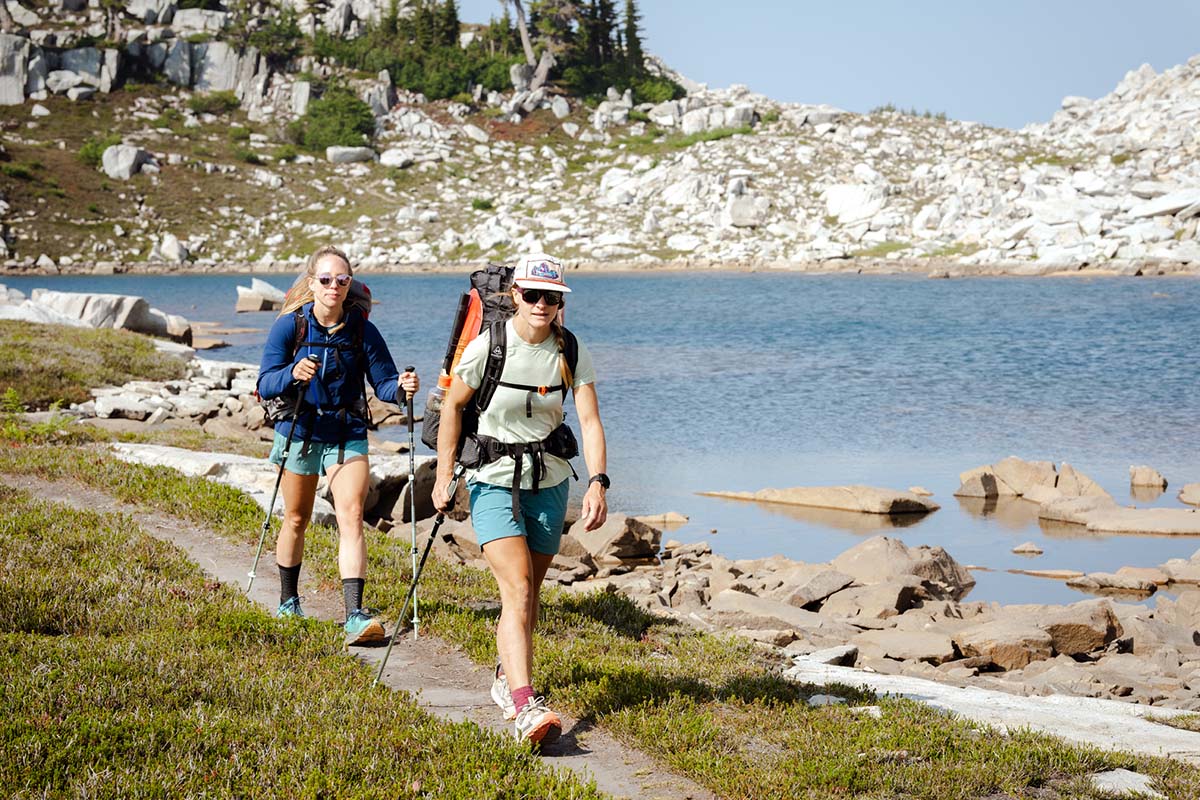
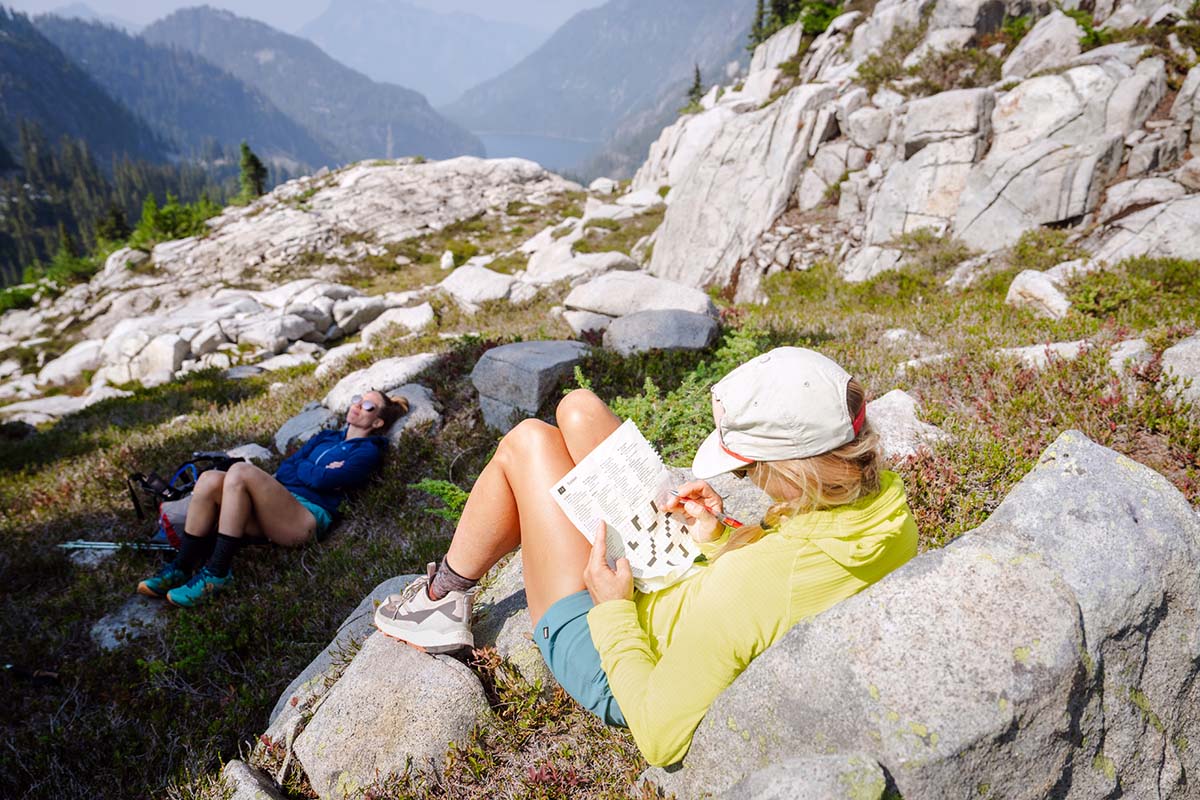
| Shoe | Price | Type | Weight | Waterproof | Upper |
|---|---|---|---|---|---|
| Adidas Free Hiker 2 Low GTX | $180 | Hiking shoe | *1 lb. 15.1 oz. | Yes (Gore-Tex) | Synthetic |
| Adidas Swift R3 GTX | $160 | Hiking/approach shoe | 1 lb. 8 oz. | Yes (Gore-Tex) | Synthetic |
| La Sportiva Spire GTX | $209 | Hiking shoe | 1 lb. 10.2 oz. | Yes (Gore-Tex) | Synthetic |
| Hoka Anacapa 2 Low GTX | $180 | Hiking shoe | 1 lb. 8.8 oz. | Yes (Gore-Tex) | Nubuck leather |
| Salomon X Ultra 4 GTX | $160 | Hiking shoe | *1 lb. 7.6 oz. | Yes (Gore-Tex) | Synthetic |
| La Sportiva TX4 | $159 | Approach shoe | *1 lb. 9.2 oz. | No | Leather |
* Typically, we list the manufacturer's advertised weight spec, but due to discrepancies we list the actual weight here (for women's size 8.5/9).
The Free Hiker 2 Low GTX is a unique hiking shoe that offers a lot more stability and protection than its looks might suggest. Terrex seems to excel in this category, and their Swift R3 GTX is another popular heavy-duty choice. The Swift R3 reminds us even more of an approach shoe, with a stiffer and firmer base and less cushion overall. If you prefer a more comfortable setup that moves well down easy trails, the Free Hiker is the clear winner, but the Swift R3 impressed us with its mountain-ready construction at a good value ($160). In the end, they’re two distinct products that have a lot of appeal for mountain-oriented hikers who prefer the low-top over a mid-height design.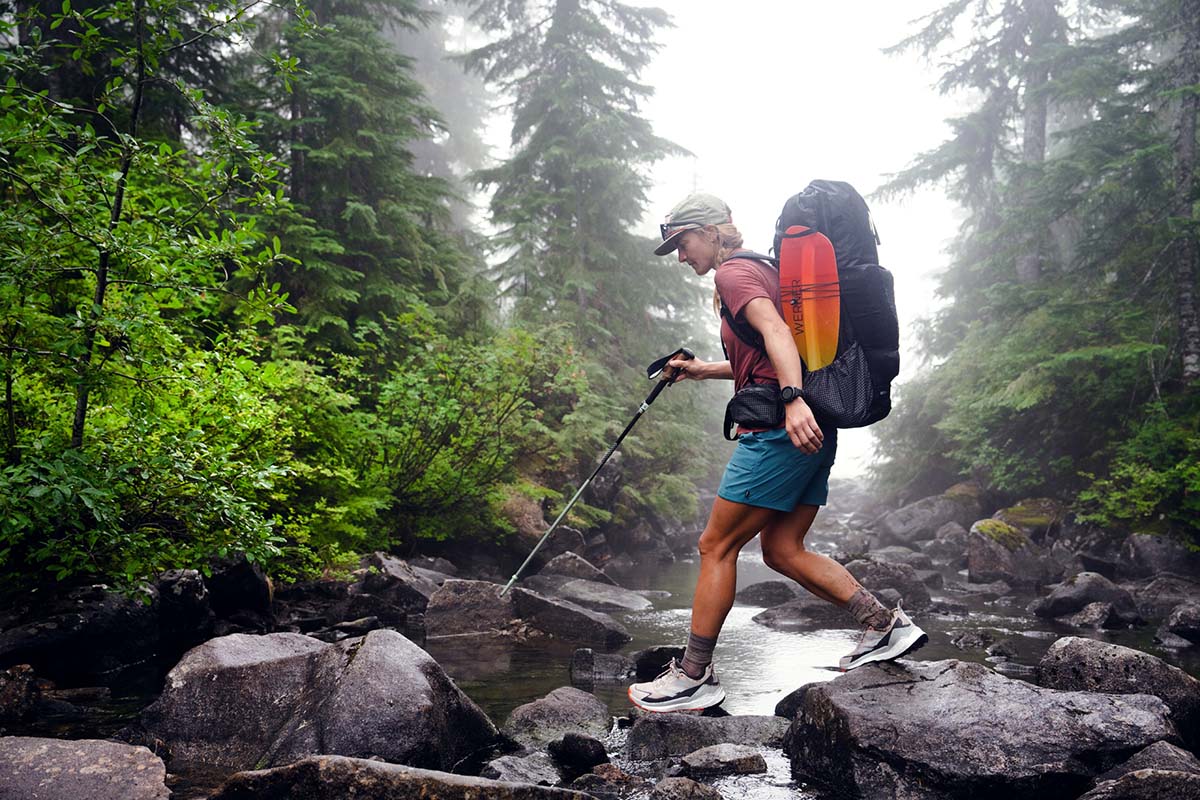
We’ve learned to trust La Sportiva for footwear, and their Spire GTX is a direct competitor to the Free Hiker 2 Low GTX. Like the Free Hiker, the Spire is fairly stiff, robust, and offers excellent protection and traction across a wide range of terrain. It also incorporates enough cushion and flex underfoot to be comfortable during high-mileage days or on easy trails. Between the two shoes, the Spire is slightly more heavy duty with stiff PU overlays at the heel and toe, and it addresses breathability concerns with ventilation ports under the foot. You do pay a premium for the added tech (the Spire is $29 more), but for serious hikers looking for a sturdy boot-like shoe (Sportiva even refers to it as a low-cut boot), the price may be worth it.
Like Adidas, Hoka is a relative newcomer to the hiking footwear space, bringing with it their signature tall stack heights and plush midsole cushioning. The Anacapa 2 Low GTX might look a little polarizing, but it’s a fully capable trail shoe and surprisingly stable despite the generous dose of midsole foam (which is noticeably firmer compared to Hoka’s running shoes). But although the Anacapa beats out most lightweight hiking shoes in terms of stability and protection, we wouldn’t push it too hard in technical terrain: The tall stack height lacks a close-to-ground feel, the large sections of exposed foam on the outsole sacrifice traction on rock and aren’t ideal for traveling over loose snow and scree, and the very wide and long footprint isn't all that trustworthy while scrambling. But for fast-moving hikers who like to incorporate a little off-trail travel, the Anacapa offers a nice mix of comfort and stability.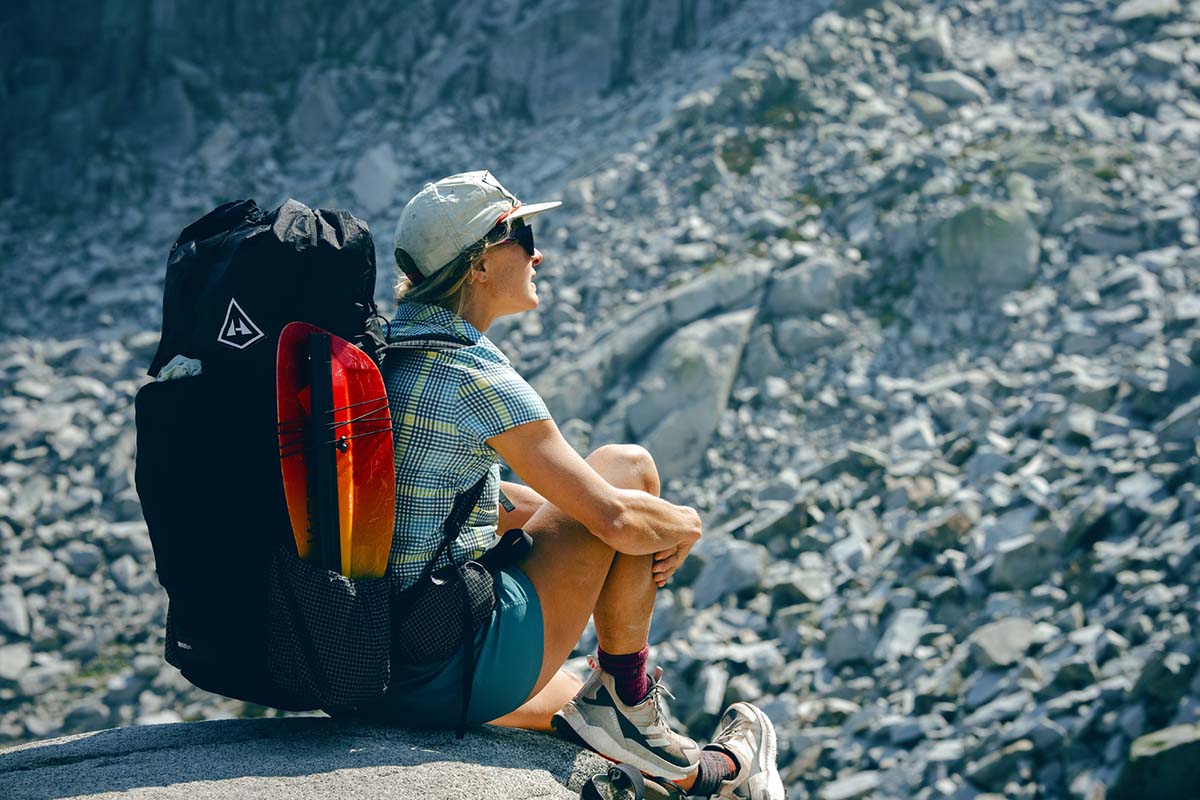
A hiking shoe comparison wouldn’t be complete without Salomon’s X Ultra 4 GTX, which is easily one of the best sellers year after year. The Salomon is by far the lighter of the two (our women’s size 8.5 checked in a half-pound lighter at 1 lb. 7.6 oz.), has similarly well-rounded traction and waterproofing, and is $20 less. It does a great job balancing out trail runner characteristics with the more robust design of a hiking shoe, but lacks the stiff sole and upper reinforcements of the Free Hiker 2 Low. We’ve taken the X Ultra 4 into some pretty serious mountain terrain while hiking in Patagonia; while it gets the job done, it doesn’t offer nearly the same confidence-inspiring stability or protection as the Terrex. We’d stick with the Free Hiker for routes that mix in cross-country travel, but the X Ultra 4 is a lighter and more agile option for the majority of hikers and backpackers (for more, see our in-depth X Ultra 4 review).
Last but not least, La Sportiva’s TX4 EVO technically is an approach shoe but has a number of similarities to the Adidas Terrex Free Hiker 2 Low. Both feel relatively stiff underfoot yet hike well and offer excellent protection for moving off trail and over rocky terrain. The La Sportiva comes in a bit cheaper ($169) and lighter than the Adidas, and its durable upper is truly hard to kill. You do, however, give up the Gore-Tex insert, and the TX4 features a stiffer forefoot that isn’t as comfortable throughout long days of easy trail hiking. It’s a wonderfully capable choice for technical rock scrambling and consistent off-trail travel, but the Free Hiker 2 is by far the more well-rounded shoe for hikers and backpackers.
If you’re thinking about buying gear that we’ve reviewed on Switchback Travel, you can help support us in the process. Just click on any of the seller links above, and if you make a purchase, we receive a small percentage of the transaction. The cost of the product is the same to you but this helps us continue to test and write about outdoor gear. Thanks and we appreciate your support!
Depending on the seller, most products ship free in the United States on orders of $50 or more. International shipping availability and rates vary by seller. The pricing information on this page is updated hourly but we are not responsible for inaccuracies.